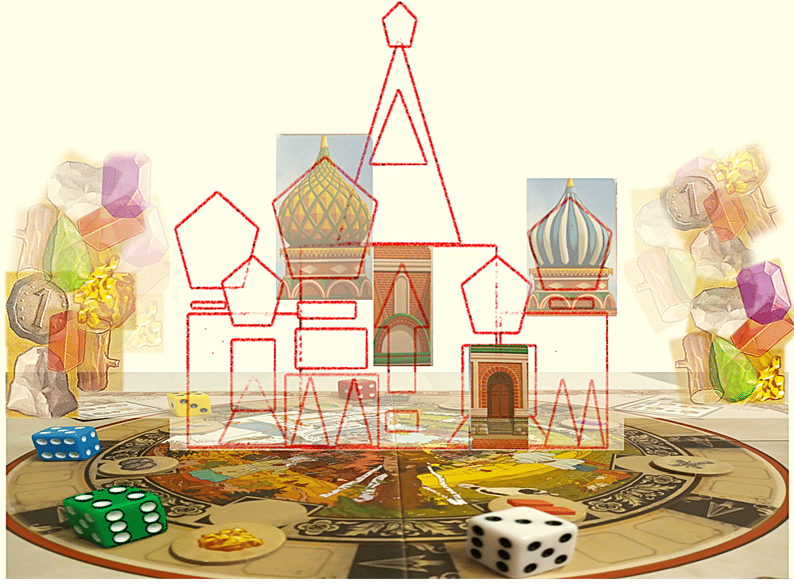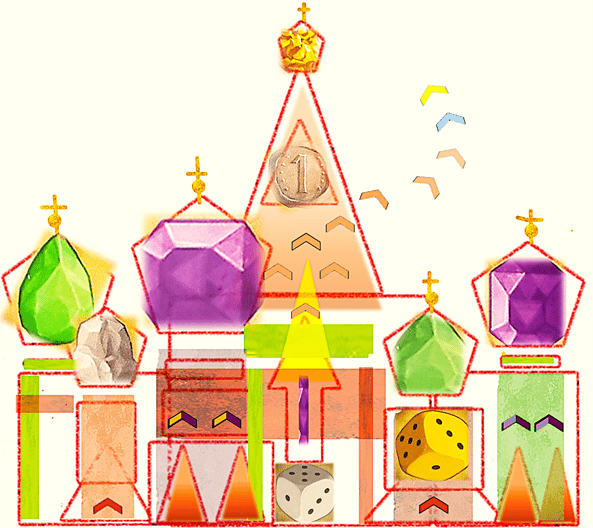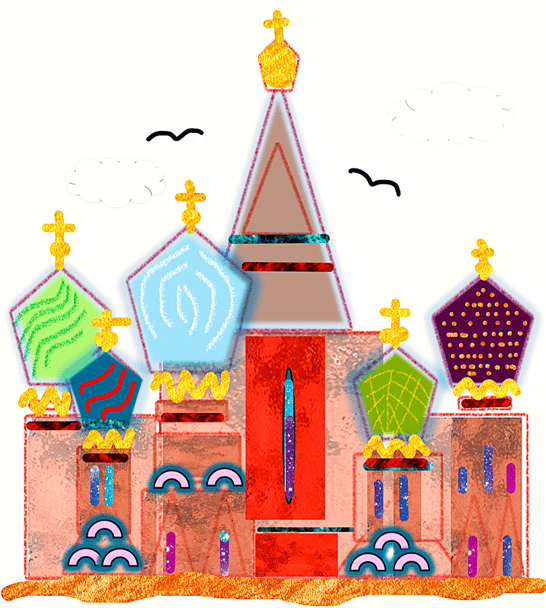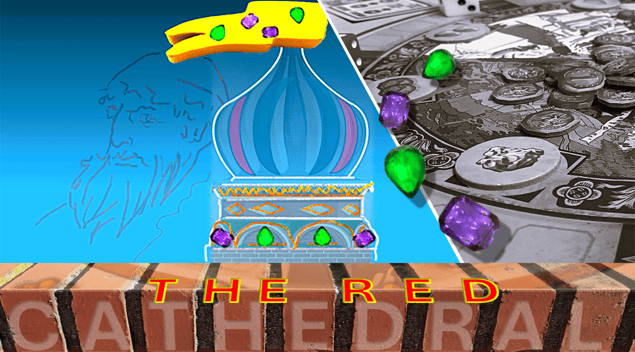Unfurling the Tsar's Spangled Banner
A review of The Red Cathedral
Chris Sanderson


Moscow's Red Cathedral ... wasn't that the building with those weird tutti-frutti topped towers? A weird basis for an entire game, wasn't it? Still, the reviews were good and the price was affordable: I decided to add it to our collection.
I'd been forewarned about unboxing the game, but nothing had prepared me for the deluge of components that spilled out on the table.
All that was missing was a pop-up model of the Red Square.
I could see I'd got my money's worth. I drooled over the jewels; loved the neat design of absolutely everything. Here was a pure bonsai euro; no bloat here, just sparky fullness, all packed Tardis-style into an unassuming box.
If the components wooed me, the gameplay wowed me. That dice rondel mechanism - neat. Those workshop tiles giving cogs and levers to the dice - clever. And the double points track ... truly double-wow.
Honestly, genius had left its mark there. I mean, who would have thought of that? Decades of crawling round the edges of gameboards in an eternal Monopo-loop, ended in one stroke. Elated, I went into warp drive around sixteenth century Russia, jumping prestige points by mere ornamentation, wormholing way ahead of where I had any logical right to be.
Only one thing dragged: the cranky goods delivery. Only three materials at a time? Come on, how do you expect me to build a cathedral with just THREE materials at a time? Then I thought, 'Well, this is Sixteenth Century Russia after all, what am I going to get, freight trains?' From then on, I tried adapting to reality. Much better, mental health-wise. And mental health was about to get very important ...
But that's for later. Right now, I was just ... happy. Beaming. Another bright, beady-eyed addition to our games collection, one to pull out once in a while. And it did get pulled out - once in a while. The 'while' might be days, weeks or months, but it got pulled out.
Once in a while.
Why am I repeating that? Well, because that was it. A repeatedly cool game, cool experience - and a nagging suspicion that I was perhaps ... missing something?
It may have been that tight delivery mechanism, or the way the dice sometimes got stuck all pointing to the same resource. Whatever the case, despite all the banners and jewels I was placing, the game itself wasn't exactly unfurling. A case of the 'Tsar's tangled banner'?
Unsure of the cause, I began to delve deeper, wondering what it was that I'd seen in those reviews that had first hooked me in. I went back to the origin of all things.


That central rondel.
I started playing again, slowly, tweaking every knob, exploring every little quirk and nuance of that rondel. And I began to see the truth.
I'd been a fool. A reckless jerk.
Yes, it's like you visit your great uncle and pick up a dice shaker-tower-thing off his dining room shelf, turn it upside down, give it a shake and say, Hmm, nice gimmick. And your great uncle says, Yes, not bad for an eight-hundred-year-old Fibonacci Sequencer. And off he wanders into the kitchen leaving you mumbling, A Fibonacci what?
Like now. I can hear you saying, A Fibonacci Sequencer - what's that? And I point to The Red Cathedral's rondel and say, Probably something like that.
No, this is rondel is no vending machine to cough up gold and logs on demand. Behind it lies some deep mathematical art that a great medieval mathematician like Fibonacci might have been proud to invent. An archaic, henge-like contraption, a generator of stone, gems, wood and gold driven by its own genius ... it makes me forget about winning the game as I just delight in its enchanted mechanisms.
This rondel, with its qualifying season cards and workshop triggers, is amazingly smart. It even makes the dice look smart.
Now I have a healthy respect for dice, but I haven't always found them the smoothest game mechanism. Yet here you should see how they've got their act together.
Take gold production, for example. You want gold - you crave gold, you absolutely must have gold, but the dice are looking the other way, playing hard to get. "I want gold! Line up, critters!" you mutter. Nothing. Then you notice a workshop tile, the green-gem one you placed in the white die section, is nudging you. "Use the white die!" it whispers. "How?" you whisper back. And then you see it. The white die is headed just past the stone section, where stone can be exchanged for ... guess what? Gold! Just pay a rouble to modify the die number, and you can stop by the quarry and do business. You even get a freebie gem from the other die tile you activated. And the dice give each other an ironic wink while you try not to show your embarrassment.
It's happened a hundred times. Dice playing dumb, hands in pockets and whistling some traditional Slavic theme, waiting for me to get the hint. Well, I'm finally getting it, guys! You are literally revolutionising my workshop, from 'empty stop-off point' into 'bustling warehouse', bursting with goods ready to be released into the grand project for which they were destined: the building of Tsar Ivan's Red Cathedral.
Just as well, because that cathedral had admittedly been causing me hassle. I mean, in the game blurb it doesn't exactly tell you the truth about Ivan's beloved project. It just gives a hint - but a very telling one.
The cathedral was built as a monument to the Tsar's own all-conquering prowess. Which means you and I, fellow architects of Russia, are being invited to share in raising a monument to the ego of an imperialistic Sixteenth Century tyrant. One with the appendage 'The Terrible'. Hmm, nice ...
Okay, so let's kick all idyllicism out the window. This cathedral - this 'Tsar's spangled banner' - is no bed of roses. It is actually a hotbed of Machiavellian rivalry and claim-staking. You'll be leapfrogging rivals, juggling interests, devising where to push for a majority share and where to just stick your foot in the door.
Luckily, however, everything changes if you have the dice on your side. They have been known to leave the cathedral's back door open. A subtle tip off, a neat little hand-out, and suddenly you get that gold and that gem you've been holding out for - and in a trice you completed your three final sections for the first-to-finish reward of three prestige points.
And nobody, not even you, saw it coming.
Well, I speak for myself. I'm often getting special deliveries I never saw coming. 'Cranky' delivery service? Boy, how wrong I was! The above example proves that three materials delivered in one turn can change everything. Why wait hours for a freight train when you've got a delivery cart ready to roll at any moment?


Yes, it's wonderful when you stop bouncing off the surface of a game and get inside its inner workings. Everything starts to click, and you're suddenly transformed from a grumpy, disillusioned old gem-grabber into a true GEM - Great Enjoyer of Mechanisms. You glow as you watch the rondel resource generator drip-feeding your hungry workshop shelves, storing stuff to be carted to the building site - three concentric circles rippling outwards, from the bowels of mines and forests to the pinnacle of Tsarist glory.
I'm convinced there's something psychotherapeutic about all this. I'm no Freud, but I know when my brain patterns are being echoed. That rondel works like my mental boiler room, the subconscious part where the raw, half-baked thoughts get churned out. These then get ordered and shelved in my conscious mind, ready to become translated into the external affairs of artful political scheming.
Seeing the cogs and gears of my mind represented like this helps me think clearly. There's a delicious clarity in this potpourri of economy, intrigue and admin. I am learning to enjoy the inner workings, the craft of the resource rondel without getting stressed by the external maneuvering over cathedral politics. The secret is knowing when to change gears - when to let the rondel purr and when to release resources at the optimum moment - without getting tangled up by your own plans in the process.
And I have even started winning regularly (to the annoyance of my family!). Something has been unlocked. I have discovered that this game is so much more than pilfering resources and racing to keep ahead of the rest. It's industry, it's share-buying, it's storytelling, it's history. The Red Cathedral, perhaps more than any other game, is teaching me to distinguish my greed from my natural business instinct, and to enjoy the latter without getting too antsy.
Fellow architects of Russia! I am no longer slaving under the shadow of Ivan's spangled banner. I'm waving my own!
Now that really is mental health ...


Hi, I am Chris Sanderson, an Englishman living near Madrid, Spain. Please send me your comments by email, or in BoardGameGeek through the links at the end of each game review.
© 2025. All rights reserved.